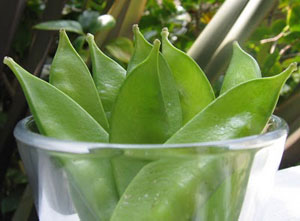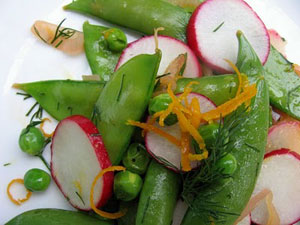 Eat your peas. That's one thing my mother never had to say to me. I always liked peas, even as a little girl. Why? Probably because my mom never overcooked them, and she always used fresh peas (well, maybe frozen occasionally, but never canned).
Eat your peas. That's one thing my mother never had to say to me. I always liked peas, even as a little girl. Why? Probably because my mom never overcooked them, and she always used fresh peas (well, maybe frozen occasionally, but never canned).
All varieties of peas have been available lately in Southern California, and their full flavor and crisp texture is incomparable. In addition to the classic English pea, there is the snow pea and, my favorite, the sugar snap pea.
Now, sometimes peas can be a bit complicated. Do I eat the pod? Can I eat it raw? What exactly does shuck mean? Thankfully, a farmer at our local market recently put up signs:
ENGLISH PEAS: DON’T EAT THE PODS
SUGAR SNAP PEAS: EAT THE WHOLE THING
No one ever has questions about the snow peas; they’re low maintenance.
The basic garden pea was cultivated in England, which is why it’s called an “English” pea. When buying English peas, look for plump, deep green, rather heavy pods, as these will have the largest peas. They can be eaten raw or cooked.
To shell the peas, simply snap off the top and pull down, until the stringy spine is removed and the pod opens up; remember to throw away the inedible pod. There are two things you should know about shelling peas:
1. They’re like spinach. You need to start off with a lot more than you think you’ll need; then you should have just enough. In general, 1 pound of peas in their pods yields about 1 cup of shelled peas.
2. Don’t shell peas by yourself. It's no fun. Plus, if you do it alone, then there won't be anyone to prevent you from eating all of the peas before you can make your recipe. Don't laugh. It happened to me. I had to buy more.
 Snow peas are typically associated with Asian cuisine; this is no coincidence, since historically, they have been cultivated in Asian countries and are also called Chinese peapods. Ever wonder why they’re flat? It’s because they're harvested while the peas are still underdeveloped. Look for snowpeas that are bright green, flat, and almost translucent. They are entirely edible and can be eaten raw or cooked.
Snow peas are typically associated with Asian cuisine; this is no coincidence, since historically, they have been cultivated in Asian countries and are also called Chinese peapods. Ever wonder why they’re flat? It’s because they're harvested while the peas are still underdeveloped. Look for snowpeas that are bright green, flat, and almost translucent. They are entirely edible and can be eaten raw or cooked.
What happens when you cross an English pea and a snow pea? You get the best pea of all: the sugar snap pea. These are crisp and sweeter than English peas and can be eaten raw or cooked (but only briefly, or the flavor and texture will suffer). When selecting sugar snap peas, look for puffed up, bright green pods. Don't worry if the pods have some white scratch marks on them; my local farmer says that's normal. Just remember to “snap” the top of the pea back and pull until you remove the stringy spine on both sides of the pod.
Though I make many dishes that highlight each of these peas, today I decided to share one that includes all three. Using the freshest dill you can find and freshly squeezed orange juice elevates this warm salad to something special. This salad could also be made using all raw vegetables and substituting red onions for the shallots and some olive oil and vinegar for the butter.
 Warm Three Pea and Radish Salad
Warm Three Pea and Radish Salad
Makes 4 side servings.
2 shallots, thinly sliced
2 Tbsp butter
1 ½ cup radishes, thinly sliced
1 cup freshly squeezed orange juice (or carton juice)
A couple of pinches of orange zest
2 cups snow peas
2 cups sugar snap peas
1 cup shelled English peas
½ cup fresh dill, chopped
Salt and pepper, to taste
In a large skillet, over medium heat, melt butter. Add the shallot; sauté 2-3 minutes. Add radishes, and sauté 1 minute more. Add the orange juice and zest. Once it begins to heat up and bubble, lower the heat, and add the snow peas and sugar snap peas, and cook 1 minute. Add the English peas, and cook another 30 seconds. Turn off heat as peas are best when al dente. Add the fresh dill, and season generously with salt and pepper. Garnish with orange zest, if desired.
Note: If you’d like the dressing a little bit thicker, then simply dissolve about 1 tsp of cornstarch in a little bit of water and add with the orange juice.
Serve as a side salad or over a cooked grain, such as couscous, for a more complete meal.
Susan Russo is a free lance food writer in San Diego, California. She publishes stories, recipes, and photos on her cooking blog, <Food Blogga and is a regular contributor to NPR’s <Kitchen Window. She is also the author of two upcoming books that will be published in the fall of 2010.

